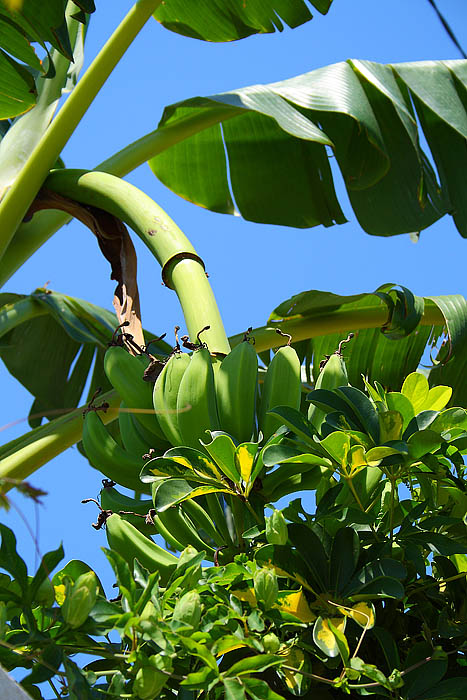The banana plant is the largest herbaceous flowering plant, in other words, it's a grass that decided to think big. The plants are normally tall and fairly sturdy and are often mistaken for trees, but their main or upright stem is actually a pseudostem that grows 6 to 7.6 metres (20 to 24.9 ft) tall, growing from a corm. Each pseudostem can produce a single inflorescence, also known as the banana heart that will in turn grow into a single bunch of bananas. After fruiting, the pseudostem dies, but offshoots may develop from the base of the plant. Many varieties of bananas are perennial.
+close-up.jpg) |
| Banana flower (Musa acuminata) close-up (© LightColourShade. All rights reserved) |
.jpg) |
| Banana fruits (Musa acuminata) (© LightColourShade. All rights reserved) |
Strelitzia nicolai, commonly known as the Giant White Bird of Paradise or Wild Banana are banana-like plants with erect woody stems reaching a height of 6 m (20 ft) and 1.8 m (6 ft) long grey-green goffered leaves arranged like a fan at the top of the stems.
The inflorescence consists of a dark blue bract, white sepals and a bluish-purple "tongue". The entire flower can be as much as 18 cm high by 45 cm long and is typically placed just above the point where the leaf fan emerges from the stem.
 |
| Strelitzia nicolai (Giant White Bird of Paradise, Wild Banana) flower (© LightColourShade. All rights reserved) |
 |
| Strelitzia nicolai (Giant White Bird of Paradise, Wild Banana) (© LightColourShade. All rights reserved) |
No comments:
Post a Comment
Speak out, I'm listening.